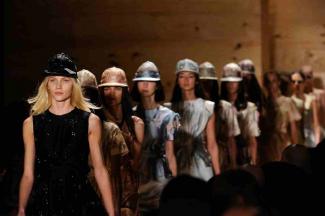


Digital culture and fashion information
The rate of online engagement has grown very fast in Brazil over the past years. Brazilians are commonly early adopters of technology and very keen on using social media, mostly pushed by the spread of smartphones, even among lower-middle-class families.
According to comScore, in 2015 Brazil’s digital population numbered 84.6 million people, 45% percent of whom access the web through multiple platforms. Through the use of mobile technologies, the online population in Brazil has increased by 11% over the past year alone, while the amount of time this population spends online has gone up by 4%.
Entertainment and social media are the two top drivers of the time spent by Brazilians online. Lifestyle ranks as the fourth largest area of interest, just below general news and above news and information. Matters specifically related to beauty, fashion and style are among the top ten subjects that are most viewed on the internet. No wonder one of Brazil’s most popular YouTube stars is a beauty and fashion icon on the YouTube channel ‘Make-up by Camila’.
Such strong internet engagement has been affecting fashion on both the cultural/social and commercial levels. Retailers and brands are rushing to adapt to a new customer demanding a real-time experience. The power of social media keeps pushing the marketing of experience – brands purposely plan their new marketing investments to generate contents that have the potential to go viral on the web.
One-time events focused on trade, such as fashion shows and fashion weeks, are no longer the exclusive territory of editors and buyers; these events now set the stage for a direct dialogue between brands and customers, in which brands exhibit desirable images and clients respond with likes, shares, comments and instant e-commerce orders.
Fashion blogging biting into traditional publicity budget
As much as open TV networks and the soap operas of the super-powerful Rede Globo television network turn actors into celebrities and make TV a fashion trendsetter, especially for the lower and middle classes, the increasing access to the internet and the fashion-blogging phenomenon have turned once-normal, well-dressed, mostly Rio/São Paulo society girls into online fashion icons who have become highly profitable media channels. It has been working almost like a former kind of branded content for fashion. Girls will tell their peers which styles they prefer and deliver a demonstration on ‘how to get the look’ as if they and their hundred million followers were next-door neighbours.
While the traditional media were still discussing whether fashion bloggers would become a threat to fashion journalism, retailers and e-commerce platforms understood that the new generation of consumers could connect with these web icons better than with any other type of media programme. Bloggers soon became online ambassadors for the campaigns of brands and the strategic target of e-commerce marketing plans.
Nowadays, all of the popular fashion bloggers in Brazil work with a structured commercial team to organise their finances and publicity. All of them count their audiences with well-elaborated media kits using combos that include not only banners and stamps, but mostly publiposts, social media mentions and offline presence at social events. The amount of business generated by such girls is influencing a new generation of teens to aspire to a blogging career. At the beginning of 2015, the traditional Belas Artes University in São Paulo launched a graduate programme in Digital Media that focuses on fashion – targeting those who believe they might also become an internet hit.
While style/fashion blogging was still a promising trend to watch, some PR and media professionals started to organise blogging platforms to bring together a team of bloggers who would then become part of a labelled portfolio. This carried the promise of an organised publicity plan, bringing advertisers and bloggers together under the consultancy of a specialist who would programme the type of media that would be most strategic for brands and blogs. Today, the most popular blog platforms in Brazil are F*Hits, Caras Blogs, Moda.It and BoutiqueB. In addition to them, and even without working from a digital platform, PR Monica Mendes, one of the ‘500 People Shaping the Global Fashion Industry’, also manages the careers and commercial strategies of Brazilian and foreign bloggers working in Brazil.
E-commerce results for fashion justify why this formula seems to have worked so well for Brazil. Of course, it hasn’t only been through the influence of internet fashion celebrities that the fashion segment has become a major business driver for the country’s e-commerce. According to the consultancy group E-bit, Brazilian e-commerce generated 16.6 billion in 2014, and fashion is the leading category, accounting for 18% of overall sales online. In Brazil, 40% of the 90 million consumers have bought at least one article of clothing through e-commerce. And a Mckinsey consultancy study projects that sales of fashion through e-commerce in Brazil may reach an annual 30% growth for the next couple of years at least.
Such e-commerce performance is a little surprising for a country where consumers are concerned about how well clothes fit, seeing as the overall Brazilian sense of style, especially for women, is more sensual/sexy than in other cultures. Until a decade ago, many people were sceptical about a strong potential for fashion e-commerce in Brazil. Today’s figures show that Brazilians are eager for information about fashion and are enthusiastic consumers of style, so, as technology becomes more familiar to them, such behavioural barriers are rapidly falling away. (In fact, Brazil’s true barriers to e-commerce are the country’s complex and high-priced logistics, combined with a highly bureaucratic and inconsistent system of taxation).
All of this serves to strengthen the fact that the rhythm of ‘see it, like it, buy it’ has infected Brazilian consumers to such high levels that the extreme opposite behaviour is starting to show up in groups advocating a ‘slow movement’. When you start to see a truly polarised reaction, this is just because something has become strong. There’s no way back, there’s just one way forward in Brazil, to the internet. Super-powerful TV networks are trying to incorporate it, in order not to become obsolete. Meanwhile, the world of fashion observes and responds, each day creating more demanding, informed and confident costumers, who are empowered to communicate through personal style.
Facebook and Instagram shaping new ‘relevance rates’
Maybe because Brazilians are mostly friendly and social by nature, the fast-growing access to the internet is immediately combined with the popularity of social media, which in many ways is greater than in any other country. Many studies indicate that one third of the time that Brazilians spend on the internet is dedicated to social media. A recent Survey Monkey research conducted in partnership with Ogilvy on the amount of time spent on social media in different countries shows Brazilians rank number one, with an average of 13.8 hours per month.
Although comScore studies show that most social media engagement is related to news and entertainment as well as content provided by each person’s social circles, fashion and lifestyle is also a significant factor in that engagement.
Fashion publications, especially Brazilian versions of international titles such as Vogue and Elle or FFW (the fashion website edited by São Paulo Fashion Week organisers), follow a global trend of making strategic use of social media – mainly Facebook and Instagram – to lead the online conversation as well as to attract viewers to their online content. As is seen worldwide, social media relevance rises when it is related to fashion icons, personalities and the influential fashion bloggers who dedicate even more time to social media than to blogging itself. This has become such big business that fashion bloggers maintain a special team to feed their site with blog posts and dedicate their time to remaining interesting on Instagram, this being the ‘official fashion social media platform’ in Brazil.
It is no surprise that in Brazil someone can become a style icon on Instagram and soon receive celebrity treatment and recognition, gaining status from media interviews and calls to participate on TV shows. An accessory recommended on Instagram by an internet celeb can arouse the same consumer desire as something worn by the most stylish character on the nine o’clock soap opera.
Because gaining Instagram popularity is not the result of investment in advertising alone, companies and brands try to figure out ways to better communicate within the platform and conduct Instagram-focused campaigns. It is common to see the communication strategies for fashion events privileging Instagram coverage to generate online buzz.
This has been shaping the industry. Nowadays, fashion marketing – from that of big powerful brands to that of small creative start-ups – is linked with an internet/social media action plan.
Continue reading Mapping Brazil - Fashion: Events